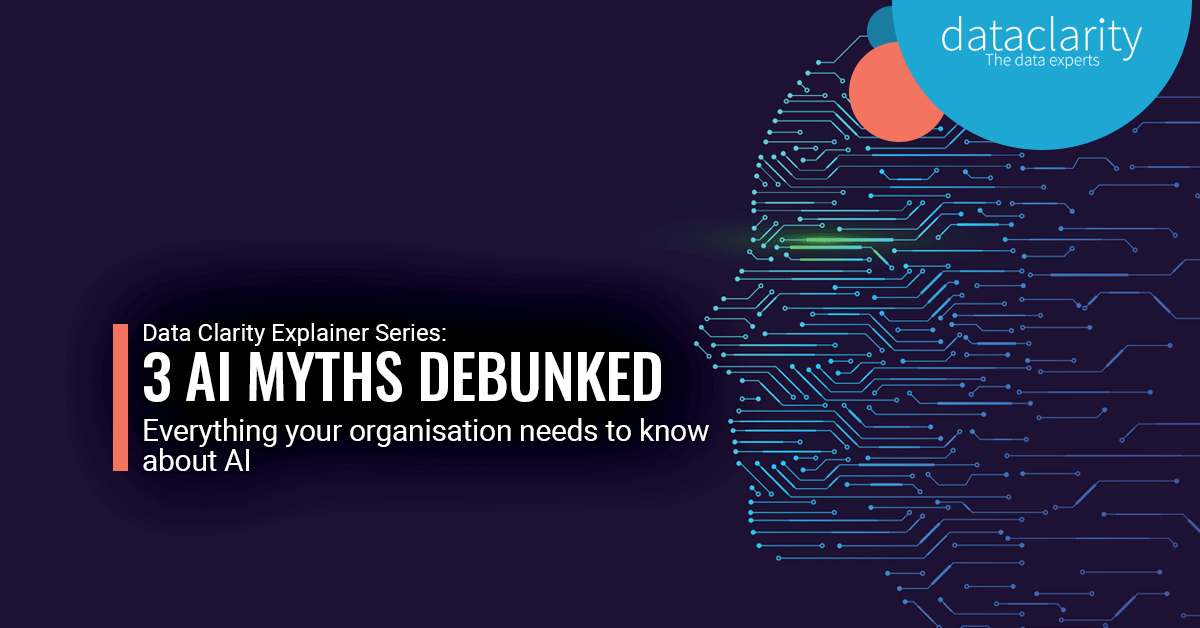3 AI Myths Debunked
11th April 2023
In this article, we have identified a few of the bigger AI myths and debunked them in the hope that business leaders can better understand the topic and set realistic expectations for the benefits of AI, while considering the limitations.
To generate value from AI and machine learning initiatives, business leaders must fully understand how AI works, the myths around AI, and where its limitations lie. At Data Clarity, we have seen a full range of opinions on the promise of AI, ranging from ‘Artificial Intelligence will automate everything and solve every business challenge’ to ‘AI is nothing more than science fiction’. The truth is more likely to be somewhere in the middle.
The hype around AI has produced many myths, in mainstream media, in board meetings and across organisations. IT and business leaders need to create value for AI by establishing business benefits such as cost reductions and operational improvement and by providing practical applications of the technology. Myths are unhelpful in this regard by setting unrealistic expectations that are sure to fail.
Here, we have unpacked a few of the bigger AI myths and debunked them below.
Myth 1: AI and machine learning (ML) means the same thing
Machine learning is a subset of the broader artificial intelligence umbrella. ML requires a well-thought-out training and data acquisition strategy. The early AI pioneers developed algorithms that were used to analyse vast amounts of data, learn about patterns in the data and then make predictions about something related to that data.
These techniques have developed and advanced over time but at a basic level, this means that a program or system is eventually able to learn how to perform a task without being hand-coded with a specific set of instructions.
The reason this is not considered true artificial intelligence is because, with machine learning, while the system is able to handle its narrow set of tasks and routines more efficiently than a human, it will not be able to perform anything outside of its specific design.
AI, on the other hand, acts as an umbrella term for a broad set of computer engineering techniques, ranging from ML and rule-based systems to optimization techniques and natural language processing (NLP).
True AI will have the ability to learn and make decisions independent – i.e. without the need for human intervention and, ultimately, does not exist yet. It is unlikely that organisations are going to start trusting millions of pounds’ worth of stocking decision-making to lines of code in the next few years, due to the natural limitations of any system (we go into these limitations in Myth 2).
Any system that claims to utilise AI technology is likely using a sub-branch of AI known as machine learning and is much closer to what most companies will likely have in mind for digital transformations involving AI in retail, now and in the future.
Summary: Machine Learning is branch of AI; AI is a broad umbrella term for multiple techniques both relevant and not.
Myth 2: AI and Machine Learning works automatically
As established in Myth 1, we will mostly be discussing ML going forward as general AI does not currently exist. A ML product often gives the false impression that it can learn on its own and therefore reduces the need for maintenance.
This is false. Experienced data scientists are needed to frame the problem ML will be tackling, prepare all data for analysis (including unifying data sets and cleansing data), determine the appropriate datasets needed, remove potential bias in the training data where possible and, most importantly, continually update the software to enable the integration of new knowledge and data into the next learning cycle.

This means that in order to attain value from any machine learning system, organisations need people in place to manage and cleanse their data and to have developed a full data strategy, aligned with business objectives. We have written a guide that provides key tips to help organisations align their data strategy to business goals.
Summary: AI is not a one-time operation. It is a continual process that needs integrating into the business strategy.
Myth 3: My business does not need AI right now
Following the previous point, every organisation should consider the potential impact of AI on its strategy and investigate how this technology can be applied to the organisation’s business problems. Organisations that take a proactive approach to AI integration will be in a stronger position to leverage the benefits in efficiency and accuracy.
In 2023, AI is the talk of the town for every organisation, and Gartner estimates that by 2024, 69% of what a manager currently does will be automated. In such a disruptive environment, enterprises need to consider how best they can integrate AI into their strategy and be ready for forthcoming disruptions.
With consideration of the appropriate use cases where AI can augment human work, decision making, as well as other functional innovation opportunities organisation-wide, businesses can optimise operations and gain a competitive advantage today.
Summary: AI can augment people and processes; organisations should consider use cases today to prepare for tomorrow.
Final Thoughts
AI, and more specifically ML, can provide organisations with tangible benefits, but the current discourse implies that AI is some sort of magic bullet that can cure any issue an organisation may have or that it is a valueless buzzword.
We have debunked some of the main myths surrounding AI in a business environment to focus on the benefits AI can provide, while highlighting the limitations and considerations needed when thinking about use cases.
If you want more information about how data and machine learning can help your organisation, talk to our data experts today.
